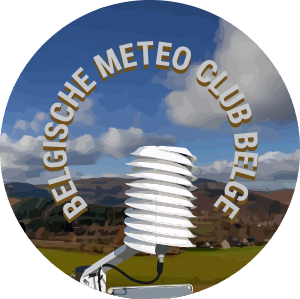
Le réseau d’observation du Belgische Météo Club Belge (BMCB) Les stations météorologiques utilisées sur l'ensemble du réseau du BMCB sont gérées par des personnes passionnées par la météo et sont toutes identiques afin de pouvoir comparer facilement leurs données de mesure. Les sites où elles ont été installées, sont des endroits bien dégagés situés soit dans des prairies, soit dans des jardins de grandes dimensions bien à l’écart de bâtiments. Les stations météo MeteoHelix dotées de capteurs de température, d’humidité, de pression atmosphérique et de rayonnement solaire, les stations MétéoRain dotées de pluviomètres et les stations MétéoWind dotées de capteurs de direction et de vitesse du vent , ont été développées par BARANI DESIGN ( https://www.baranidesign.com/ ). Ces stations météorologiques qui sont donc également utilisées par l’Institut Royal Météorologique ont été préalablement largement testées pour leur précision dans diverses conditions météorologiques et répondent aux normes de l'OMM (Organisation météorologique mondiale). Les appareils fonctionnent de manière entièrement automatique en envoyant les données toutes les 10 minutes via un réseau IoT (IoT = Internet-of-Things). Cela signifie qu'une station météo peut être placée n'importe où tant qu'il y a une bonne couverture du réseau de communication. L'IoT est très économe en énergie qui est obtenue à partir d'un (petit) panneau solaire qui assure même avec peu ou pas de soleil, comme pendant la sombre période hivernale, le bon fonctionnement de la station météo pendant des mois. |
Het netwerk van de Belgische Meteo Club Belge (BMCB) De gebruikte weerstations van het BMCB netwerk zijn beheerd door mensen met een passie voor het weer en allemaal identiek aan elkaar zodat ze eenvoudig met elkaar kunnen vergeleken worden. De opstelling ervan is zo vrij en open mogelijk. Voor het meten van de temperatuur en andere parameters wordt gebruik gemaakt van het MeteoHelix-weerstation ontwikkeld door BARANI DESIGN ( https://www.baranidesign.com/ ). Deze meteorologische stations, die dus ook door het Koninklijk Meteorologisch Instituut worden gebruikt, zijn eerder uitvoerig getest op hun nauwkeurigheid onder verschillende weersomstandigheden en voldoen aan de normen van de WMO (Wereld Meteorologische Organisatie). De gebruikte weerstations werken volledig automatisch. Elke 10 minuten worden nieuwe gegevens doorgestuurd. Dit gebeurt over een IoT-netwerk (IoT = Internet-of-Things). Daardoor kan een weerstation eender waar geplaatst worden zolang er maar dekking van het netwerk is. IoT is bovendien zeer energiezuinig waardoor energie uit een (klein) zonnepaneel wordt gehaald. Maar zelfs zonder zon - bijvoorbeeld tijdens de donkere winterperiode - kan het weerstation gedurende maanden metingen verrichten en doorsturen. |
The observation network of the Belgische Météo Club Belge (BMCB) The weather stations used across the BMCB network are managed by people who are passionate about the weather and are all identical so that their measurement data can be easily compared. The places where they have been installed are open areas located either in meadows or in large gardens well away from buildings. The MeteoHelix weather stations are equipped with temperature, humidity, atmospheric pressure and solar radiation sensors, MeteoRain stations with rain gauges and MeteoWind stations with wind direction and speed sensors and were developed by BARANI DESIGN ( https://www.baranidesign.com/). These weather stations are also used by the Royal Meteorological Institute in its climatological network and have been extensively tested for accuracy in various weather conditions and meet WMO (World Meteorological Organization) standards. The devices operate fully automatically, sending data every 10 minutes via an IoT network (IoT = Internet-of-Things). This means that a weather station can be placed anywhere as long as there is good coverage of the communication network. The IoT is very energy efficient which is obtained from a (small) solar panel which ensures even with little or no sun, such as during the dark winter period, the proper functioning of the weather station for months. |